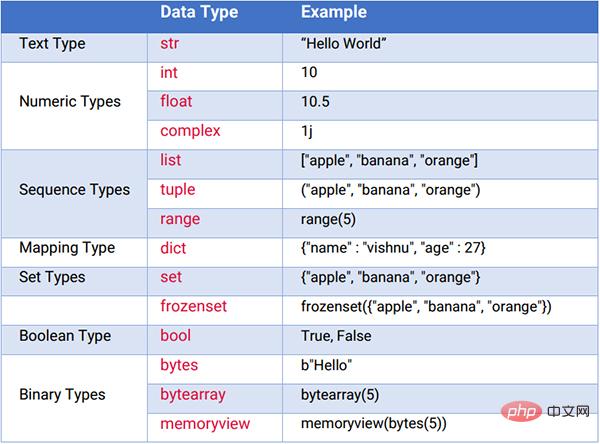Home > Article > Backend Development > Collection of 13 essential Python knowledge suggestions

Python has ranked first in the programming language popularity index PYPL many times.
It is considered the simplest language ever created due to its code readability and simpler syntax.
The richness of various AI and machine learning libraries such as NumPy, Pandas, and TensorFlow is one of the core requirements of Python.
If you are a data scientist or a beginner in AI/machine learning, then Python is the right choice to start your journey.
This time, Xiao F will take you to explore some basic knowledge of Python programming, which is simple but very useful.
Data type is a data specification that can be stored in a variable. The interpreter allocates memory for variables based on their type.
The following are the various data types in Python.

Variables are containers that store data values.
Variables can use short names (such as x and y) or more descriptive names (age, carname, total_volume).
Python variable naming rules:
var1 = 'Hello World' var2 = 16 _unuseful = 'Single use variables'
The output is as follows.

A list (List) is an ordered and changeable collection that allows duplicate members.
It may not be homogeneous, we can create a list containing different data types such as integers, strings and objects.
>>> companies = ["apple","google","tcs","accenture"]
>>> print(companies)
['apple', 'google', 'tcs', 'accenture']
>>> companies.append("infosys")
>>> print(companies)
['apple', 'google', 'tcs', 'accenture', 'infosys']
>>> print(len(companies))
5
>>> print(companies[2])
tcs
>>> print(companies[-2])
accenture
>>> print(companies[1:])
['google', 'tcs', 'accenture', 'infosys']
>>> print(companies[:1])
['apple']
>>> print(companies[1:3])
['google', 'tcs']
>>> companies.remove("infosys")
>>> print(companies)
["apple","google","tcs","accenture"]
>>> companies.pop()
>>> print(companies)
["apple","google","tcs"]Set is an unordered and unindexed collection with no duplicate members.
Useful for removing duplicate entries from a list. It also supports various mathematical operations such as union, intersection and difference.
>>> set1 = {1,2,3,7,8,9,3,8,1}
>>> print(set1)
{1, 2, 3, 7, 8, 9}
>>> set1.add(5)
>>> set1.remove(9)
>>> print(set1)
{1, 2, 3, 5, 7, 8}
>>> set2 = {1,2,6,4,2}
>>> print(set2)
{1, 2, 4, 6}
>>> print(set1.union(set2))# set1 | set2
{1, 2, 3, 4, 5, 6, 7, 8}
>>> print(set1.intersection(set2)) # set1 & set2
{1, 2}
>>> print(set1.difference(set2)) # set1 - set2
{8, 3, 5, 7}
>>> print(set2.difference(set1)) # set2 - set1
{4, 6}A dictionary is a variable collection of unordered items as key-value pairs.
Different from other data types, it saves data in a [key:value] pair format instead of storing individual data. This feature makes it the best data structure for mapping JSON responses.
>>> # example 1
>>> user = { 'username': 'Fan', 'age': 20, 'mail_id': 'codemaker2022@qq.com', 'phone': '18650886088' }
>>> print(user)
{'mail_id': 'codemaker2022@qq.com', 'age': 20, 'username': 'Fan', 'phone': '18650886088'}
>>> print(user['age'])
20
>>> for key in user.keys():
>>> print(key)
mail_id
age
username
phone
>>> for value in user.values():
>>>print(value)
codemaker2022@qq.com
20
Fan
18650886088
>>> for item in user.items():
>>>print(item)
('mail_id', 'codemaker2022@qq.com')
('age', 20)
('username', 'Fan')
('phone', '18650886088')
>>> # example 2
>>> user = {
>>> 'username': "Fan",
>>> 'social_media': [
>>> {
>>> 'name': "Linkedin",
>>> 'url': "https://www.linkedin.com/in/codemaker2022"
>>> },
>>> {
>>> 'name': "Github",
>>> 'url': "https://github.com/codemaker2022"
>>> },
>>> {
>>> 'name': "QQ",
>>> 'url': "https://codemaker2022.qq.com"
>>> }
>>> ],
>>> 'contact': [
>>> {
>>> 'mail': [
>>> "mail.Fan@sina.com",
>>> "codemaker2022@qq.com"
>>> ],
>>> 'phone': "18650886088"
>>> }
>>> ]
>>> }
>>> print(user)
{'username': 'Fan', 'social_media': [{'url': 'https://www.linkedin.com/in/codemaker2022', 'name': 'Linkedin'}, {'url': 'https://github.com/codemaker2022', 'name': 'Github'}, {'url': 'https://codemaker2022.qq.com', 'name': 'QQ'}], 'contact': [{'phone': '18650886088', 'mail': ['mail.Fan@sina.com', 'codemaker2022@qq.com']}]}
>>> print(user['social_media'][0]['url'])
https://www.linkedin.com/in/codemaker2022
>>> print(user['contact'])
[{'phone': '18650886088', 'mail': ['mail.Fan@sina.com', 'codemaker2022@qq.com']}]Single-line comments, starting with the pound character (#), followed by a message and ending at the end of the line.
# 定义用户年龄 age = 27 dob = '16/12/1994' # 定义用户生日
Multi-line comments, enclosed in special quotation marks ("""), you can put the message in multiple lines.
""" Python小常识 This is a multi line comment """
print The () function prints the provided message in the console. In addition, you can also provide file or buffer input as a parameter for printing on the screen.
print(object(s), sep=separator, end=end, file=file, flush=flush)
print("Hello World") # prints Hello World
print("Hello", "World")# prints Hello World?
x = ("AA", "BB", "CC")
print(x) # prints ('AA', 'BB', 'CC')
print("Hello", "World", sep="---") # prints Hello---WorldThe input() function is used to collect user input from the console.
It’s important to note here that input() will convert anything you enter into a string.
So if you provide age as an integer value, but the input() method converts it as The string is returned, and you need to manually convert it to an integer.
>>> name = input("Enter your name: ")
Enter your name: Codemaker
>>> print("Hello", name)
Hello Codemakerlen() can check the length of the object. If you enter a string, you can get the number of characters in the specified string.
>>> str1 = "Hello World"
>>> print("The length of the stringis ", len(str1))
The length of the stringis 11str() is used to convert other data types to string values.
>>> str(123) 123 >>> str(3.14) 3.14
int() is used to convert strings to integers.
>>> int("123")
123
>>> int(3.14)
3Conditional statements are blocks of code used to change the flow of a program based on specific conditions. These statements are executed only when a specific condition is met.
In Python, we use if, if- else, loop (for, while) as a conditional statement to change the flow of the program based on certain conditions.
if-else statement.
>>> num = 5
>>> if (num > 0):
>>>print("Positive integer")
>>> else:
>>>print("Negative integer")elif statement.
>>> name = 'admin'
>>> if name == 'User1':
>>> print('Only read access')
>>> elif name == 'admin':
>>> print('Having read and write access')
>>> else:
>>> print('Invalid user')
Having read and write accessA loop is a conditional statement used to repeat certain statements (in its body) until a certain condition is met.
In Python, we usually use for and while Loop.
for loop.
>>> # loop through a list >>> companies = ["apple", "google", "tcs"] >>> for x in companies: >>> print(x) apple google tcs >>> # loop through string >>> for x in "TCS": >>>print(x) T C S
The range() function returns a sequence of numbers, which can be used as a for loop control.
It basically requires three parameters, where The second and third are optional. The parameters are the start value, stop value and step number. The step number is the incremental value of the loop variable for each iteration.
>>> # loop with range() function >>> for x in range(5): >>>print(x) 0 1 2 3 4 >>> for x in range(2, 5): >>>print(x) 2 3 4 >>> for x in range(2, 10, 3): >>>print(x) 2 5 8
We can also use else The keyword executes some statements at the end of the loop.
Provides the else statement at the end of the loop and the statements that need to be executed at the end of the loop.
>>> for x in range(5):
>>>print(x)
>>> else:
>>>print("finished")
0
1
2
3
4
finishedwhile loop.
>>> count = 0 >>> while (count < 5): >>>print(count) >>>count = count + 1 0 1 2 3 4
us You can use else at the end of a while loop, similar to a for loop, to execute some statements when the condition is false.
>>> count = 0
>>> while (count < 5):
>>>print(count)
>>>count = count + 1
>>> else:
>>>print("Count is greater than 4")
0
1
2
3
4
Count is greater than 4函数是用于执行任务的可重用代码块。在代码中实现模块化并使代码可重用,这是非常有用的。
>>> # This prints a passed string into this function
>>> def display(str):
>>>print(str)
>>>return
>>> display("Hello World")
Hello World即使语句在语法上是正确的,它也可能在执行时发生错误。这些类型的错误称为异常。我们可以使用异常处理机制来避免此类问题。
在Python中,我们使用try,except和finally关键字在代码中实现异常处理。
>>> def divider(num1, num2):
>>> try:
>>> return num1 / num2
>>> except ZeroDivisionError as e:
>>> print('Error: Invalid argument: {}'.format(e))
>>> finally:
>>> print("finished")
>>>
>>> print(divider(2,1))
>>> print(divider(2,0))
finished
2.0
Error: Invalid argument: division by zero
finished
None字符串是用单引号或双引号(',")括起来的字符集合。
我们可以使用内置方法对字符串执行各种操作,如连接、切片、修剪、反转、大小写更改和格式化,如split()、lower()、upper()、endswith()、join()和ljust()、rjust()、format()。
>>> msg = 'Hello World'
>>> print(msg)
Hello World
>>> print(msg[1])
e
>>> print(msg[-1])
d
>>> print(msg[:1])
H
>>> print(msg[1:])
ello World
>>> print(msg[:-1])
Hello Worl
>>> print(msg[::-1])
dlroW olleH
>>> print(msg[1:5])
ello
>>> print(msg.upper())
HELLO WORLD
>>> print(msg.lower())
hello world
>>> print(msg.startswith('Hello'))
True
>>> print(msg.endswith('World'))
True
>>> print(', '.join(['Hello', 'World', '2022']))
Hello, World, 2022
>>> print(' '.join(['Hello', 'World', '2022']))
Hello World 2022
>>> print("Hello World 2022".split())
['Hello', 'World', '2022']
>>> print("Hello World 2022".rjust(25, '-'))
---------Hello World 2022
>>> print("Hello World 2022".ljust(25, '*'))
Hello World 2022*********
>>> print("Hello World 2022".center(25, '#'))
#####Hello World 2022####
>>> name = "Codemaker"
>>> print("Hello %s" % name)
Hello Codemaker
>>> print("Hello {}".format(name))
Hello Codemaker
>>> print("Hello {0}{1}".format(name, "2022"))
Hello Codemaker2022>>> import re
>>> phone_num_regex = re.compile(r'ddd-ddd-dddd')
>>> mob = phone_num_regex.search('My number is 996-190-7453.')
>>> print('Phone number found: {}'.format(mob.group()))
Phone number found: 996-190-7453
>>> phone_num_regex = re.compile(r'^d+$')
>>> is_valid = phone_num_regex.search('+919961907453.') is None
>>> print(is_valid)
True
>>> at_regex = re.compile(r'.at')
>>> strs = at_regex.findall('The cat in the hat sat on the mat.')
>>> print(strs)
['cat', 'hat', 'sat', 'mat']好了,本期的分享就到此结束了,有兴趣的小伙伴可以自行去实践学习。
The above is the detailed content of Collection of 13 essential Python knowledge suggestions. For more information, please follow other related articles on the PHP Chinese website!